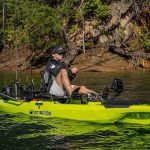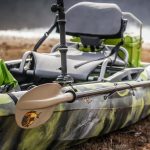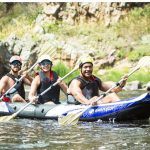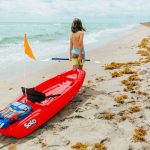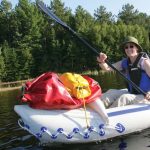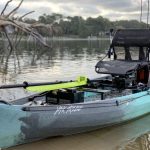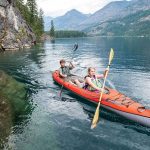Founded in 2016, Bonafide Kayaks is a relative newcomer to the kayak fishing market. 100% made in the USA, their kayaks are known for uncompromised quality and great stability. Let's see what Bonafide Kayaks has to offer in 2023.
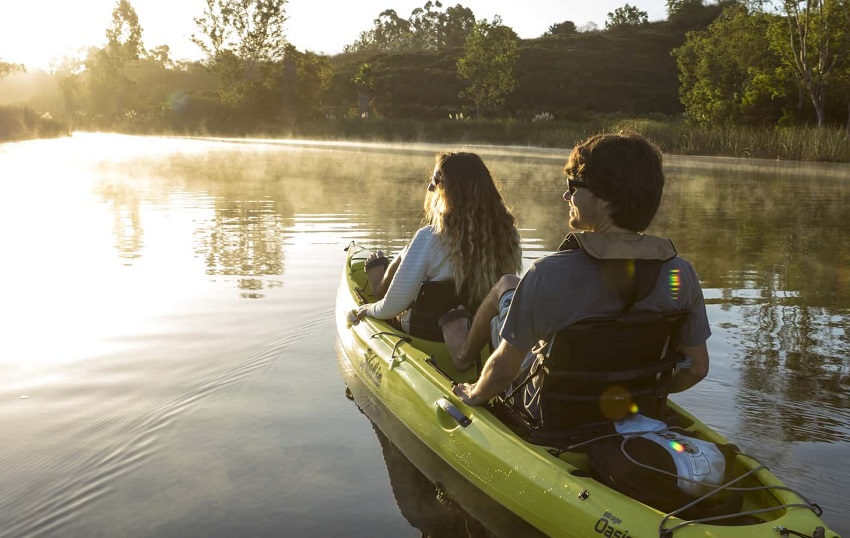
Tandem pedal kayaks allow you and your paddling partner to take to the water and keep your hands free. These kayaks are popular with kayak anglers and photographers, as well as those with limited mobility.
When compared with other types of kayak, there are few tandem pedal kayak models on the market at the minute, but they are increasing in popularity. Our buyer’s guide and selection of the best tandem pedal kayaks will help you to pick the right kayak for you and your paddling buddy.
As an affiliate of Amazon and other retailers, we may earn a small commission when you buy via our links, at no additional cost to you. Thank you!
The Best Tandem Pedal Kayaks At a Glance
Comparison table: Best Tandem Pedal Kayaks
| Model | Specs | Where To Buy |
Hobie iTrek Mirage 14 Duo | Size: 13 ft. 8 in. x 44 in. Weight: 73 lbs Capacity: 600 lb | Eco Fishing Shop |
FeelFree Lure II Tandem | Size: 14 ft. 2 in x 36 in. Weight: 105 lbs Capacity: 500 lbs | Eco Fishing Shop |
Hobie Mirage Oasis | Size: 14 ft. 6 in. x 33 in. Weight: 127 lbs Capacity: 550 lbs | Eco Fishing Shop |
 Brooklyn Kayak Company PK14 | Size: 14 ft. x 34 in. Weight: 95 lbs Capacity: 670 lbs | Amazon |
The Best Tandem Pedal Kayaks
Hobie Mirage iTrek 14 Duo
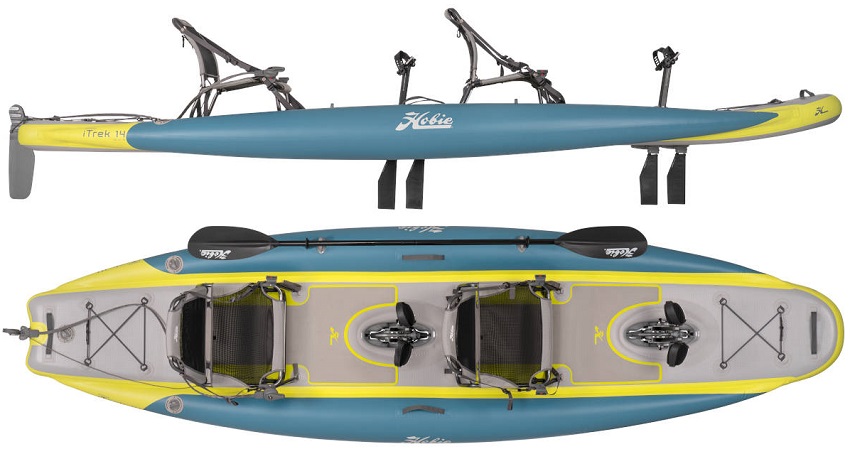
Length: 13 ft. 8 in. (4.17 m)
Width: 44 in. (120 cm)
Weight: 73 lbs. (33 kg)
Capacity: 600 lbs. (272 kg)
Drive System: Mirage GT
The Hobie Mirage iTrek 14 Duo is one of the most accessible kayaks on the market. This open design looks like a paddleboard and with the central chamber supported by two outrigger-style chambers, this is a highly stable option. There are EVA foam pads in front of each seat to make standing more secure.
With three locking valves, a high-pressure design, and 550 denier PVC outer, the iTrek 14 Duo has the feel of a plastic hull without the bulk and transport issues. It inflates quickly so you can be on the water faster and deflates into a small package that can fit in the trunk of your car and stows easily at home.
The Mirage GT Drive is an efficient fin-drive system. These fins are designed to kick up if they come into contact with underwater obstacles or shallow areas, reducing breakages and repair bills. The fully adjustable mesh-backed seats are comfortable and well ventilated, so you can stay on the water all day.
Pros:
- Inflatable kayaks are easy to transport and store
- Highly stable
- Efficient kick-up fin drive
Cons:
- No reverse drive
- Low profile leaves you open to waves crashing over your kayak
FeelFree Lure II Tandem
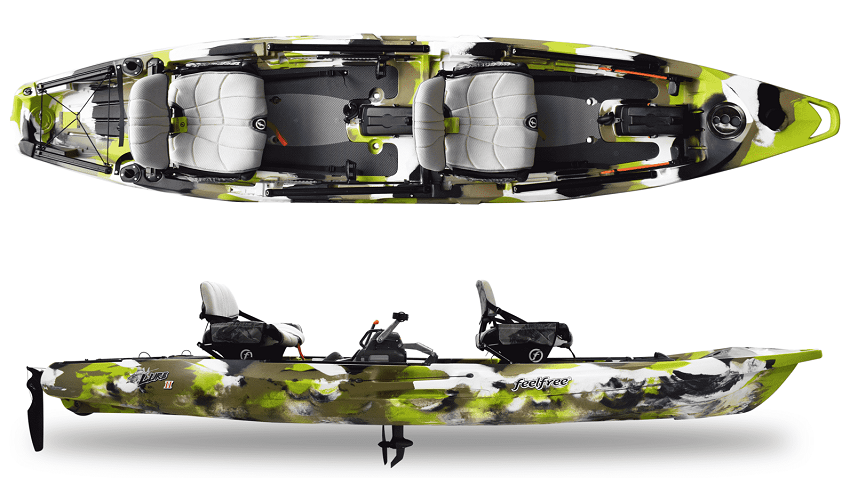
Length: 14 ft. 2 in. (4.3 m)
Width: 36 in. (91 cm)
Weight: 105 lbs. (47 kg) – Hull only
Capacity: 500 lbs. (227 kg)
Drive System: Overdrive
The FeelFree Lure II Tandem is a highly stable fishing kayak that is fast and smooth over the water. The Overdrive system is fitted for the rear kayaker to use, leaving the bow paddler free to fish, or simply sit back and relax. The front seat can be removed for solo paddlers who want extra space in the boat.
The Overdrive system is a fully reversible propellor drive system that can also be turned into a motor drive. With the addition of Motordrive that FeelFree sells separately, and you can quickly transition from pedaling to powered drive. This system pairs with FeelFree’s 8Ball steering system and Beaver Tail rudder for effortless steering.
The FeelFree Lure II is a kayak designed specifically with anglers in mind. Large EVA foam pads in front of each seating position give you a secure area to stand and cast from, while the raised mesh seats are comfortable and breathable enough to keep you out on the water all day. Flush-mounted rod holders and full-sided gear tracks let you set up your ride to suit your style.
Pros:
- Reversible drive system
- Compatible with a motor drive system
- Fishing specific features
Cons:
- Heavy kayak even before the addition of the drive system
- Only one drive system
Hobie Mirage Oasis
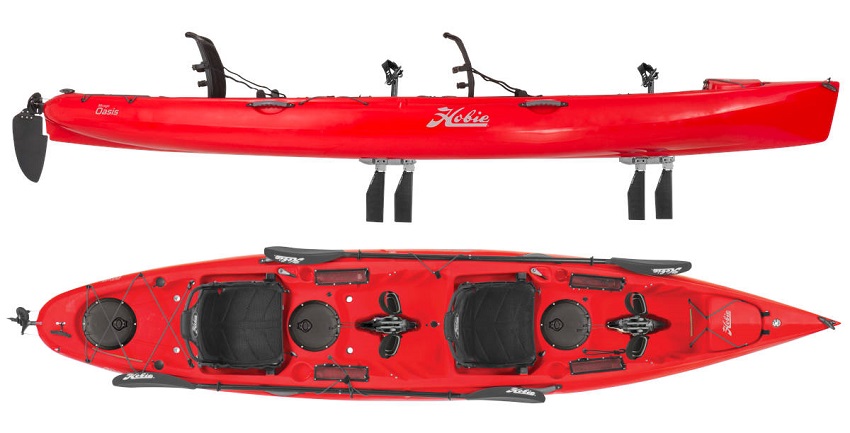
Length: 14 ft. 6 in. (4.42 m)
Width: 33 in. (84 cm)
Weight: 127 lbs. (58 kg)
Capacity: 550 lbs. (249 kg)
Drive System: Mirage 180 Drive
The Hobie Mirage Oasis is a fishing-ready kayak designed to cover long distances with ease. Dual Mirage 180 Drive systems let you switch quickly from forward to reverse, while dual rudder controls mean you can take it in turns to steer. The Mirage 180 Drive system features kick-up fins that raise out of the way if they come into contact with underwater obstacles.
The long waterline and defined keel of the Hobie Mirage Oasis make it suitable for battling more challenging conditions. This kayak holds its course well against the wind, while the rudder system allows it to turn in tight spaces.
The Mirage Oasis is loaded with storage options so you can load up all the gear you need to fish. There are four storage hatches fitted into the hull of this kayak, as well as bow and stern storage areas that are secured with shock cord. Smaller items can be stored within easy reach in the mesh pockets fitted in front of each of the removable and four-way adjustable Vantage CT seats.
Pros:
- Plenty of storage
- Dual reversible drive systems
- Good speed and tracking
Cons:
- Limited room to stand and cast
- Heavy
Brooklyn Kayak Company PK14
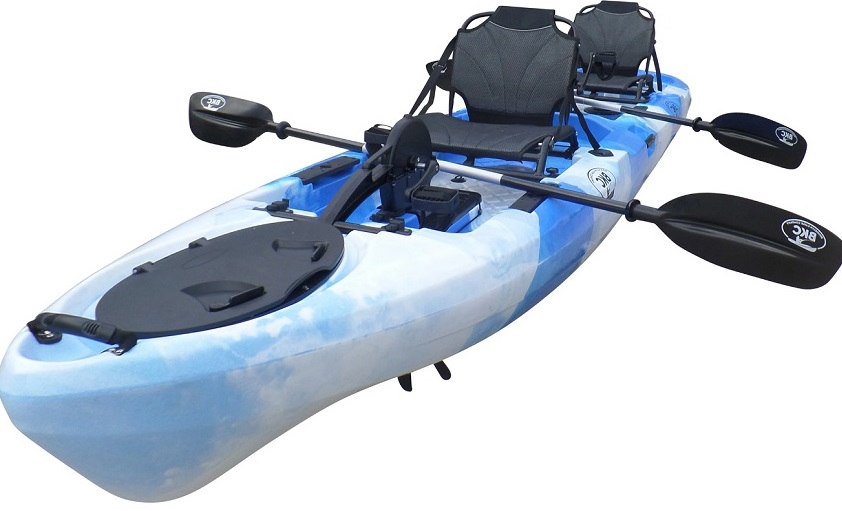
Length: 14 ft. (4.2 m)
Width: 34 in. (86 cm)
Weight: 95 lbs. (43 kg)
Capacity: 670 lbs. (304 kg)
Drive System: Instant reverse pedal drive
The twin-hull style design of the BKC PK14 makes for an extremely stable kayak, while the long waterline and defined keel help you to cruise in a straight line. This kayak features two reversible pedal drive systems and a hand-operated rudder, fitted at the rear seat position. These drive systems can be removed and replaced with a trolling motor.
The BCK PK14 is designed with the fishing kayaker in mind. You can head out with a tandem partner or remove the front seating position and open up enormous amounts of extra storage space as a solo paddler. The gripped flooring in front of each seat is designed to allow you to stand and cast while the scuppers help keep the floor dry.
The PK14 has a large cargo space at the rear, as well as a bow hatch for storing valuable equipment. There are three flush-mounted rod holders, as well as two gear mounting points for each kayaker. The adjustable seats are mesh-lined and breathable, so you can stay out fishing all day.
Pros:
- Instant reverse drive systems
- Stable design
- High capacity
Cons:
- Limited storage for crates and coolers
Buyer’s Guide
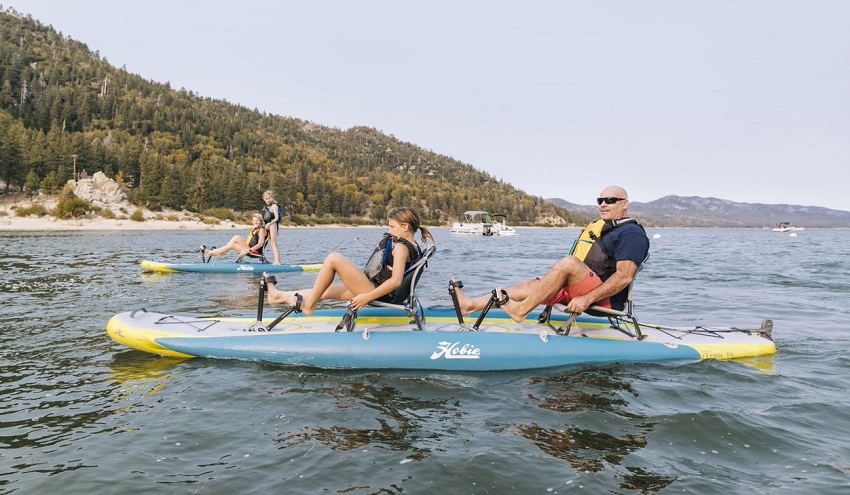
Why buy a tandem pedal kayak?
When people think of tandem kayaks, they will usually have images of two people swinging their paddles in unison to propel the kayak. But tandem pedal kayaks are becoming increasingly popular among recreational kayakers, anglers, and photographers.
The ability to go hands-free on the water allows you to shoot a photo or cast a rod on the move. Even better, it means that by allowing your arms to relax while you pedal yourself between fishing spots, you don’t need to rest when you reach your destination.
Compared with paddle kayaks, pedal kayaks are generally quicker and more efficient, while causing less underwater disturbances. These kayaks are suited to everyone, but can also help to make kayaking accessible for youngsters and those with limited upper-body mobility to use a paddle.
Dimensions
Every kayak is designed and built with a specific set of dimensions that will affect how they perform. The length and width are the two dimensions that have the biggest impact on your kayak’s performance.
The length of your kayak will affect straight-line speed and turning. Longer kayaks are faster over the water and track better against the wind, holding their course even in rough conditions. The longer your kayak, though, the harder it will be to make tight turns.
If you want a kayak to go long distances, look for length, but if you need to make tight turns a lot then a shorter kayak will be easier to control.
The width of your kayak affects the stability but also has an impact on your speed. Wider kayaks are more stable than narrow kayaks. This is most important for getting on or off your kayak, or if you prefer to stand to fish. The extra hull of a wider kayak does drag in the water though and will have a negative impact on the top speed.
Capacity
Kayak capacity is stated by the manufacturers at the point where your kayak will no longer be fully afloat. In order to maintain the optimal performance of your kayak, it is generally recommended not to exceed 70% of your kayak’s capacity. For example, if your kayak has a capacity of 300 lbs., you should not load more than 210 lbs. of weight on board.
When you work out your kayaking weight, remember to include the full weight of both kayakers, as well as clothing and equipment. This includes any fishing equipment and camera equipment, but in a pedal kayak it also often includes the drive system too. The capacity stated is usually for the hull alone and all ‘extras’ are part of your weight.
Weight
Tandem pedal kayaks are among the heaviest models on the market. These kayaks are usually 14 ft. or more in length and all that plastic adds up. The drive systems are usually removable, though, as are the seats, and this makes it easier to load up and transport your tandem pedal kayak.
All that weight needs to be moveable for you and your kayaking partner. If you tend to paddle with a child or a kayaker with limited mobility, you could benefit from a lighter kayak that is easier to move. It’s also important to check your roof rack system is strong enough to take the weight.
Drive System
Not all drive systems are created equal. Some drive systems use propellors, while others use fins. Most propellor systems are quick and easy to reverse simply by pedaling backward. These systems also have fewer moving parts than fins and can take less maintenance.
Fin systems are easy to use and are becoming more common on boats. They are less likely to get tangled up in weeds and some of them are designed to lift if they come into contact with shallows or rocks. This stops your fin system from breaking easily.
Your drive system should suit you as a person. If you struggle with mobility then the push system that comes with most fins might be easier to operate than a traditional pedal system. Make sure the seat is fully adjustable so you can reach the pedals without straining.
Features
Depending on your style of kayaking you might want a model that comes with all the optional extras. These might be fishing-specific features such as rod holders and gear mounts, or they might be more generalized.
Storage can be important to consider. If you carry a lot of dry bags, crates, or coolers, then look for kayaks with onboard storage wells. But if you have important gear that has to stay dry, hatches are more secure and waterproof.
There are also tandem pedal kayaks that can have a trolling motor added instead of one of the pedal drives. This lets you cruise effortlessly on big days out or in tougher conditions.

